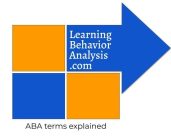B-12: Define and provide examples of motivating operations ©
Want this as a downloadable PDF? Click here!
Target Terms: Motivating Operations, Conditioned Motivated Operations Reflexive (CMO-R), Conditioned Motivating Operations Transitive (CMO-T), Conditioned Motivating Operations Surrogate (CMO-S)

It can help to think of any MO as being along the “deprivation/satiation” continuum. For example, deprivation of attention from a friend increases the reinforcing value of attention from friends. Satiation on sleeping reduces the value of sleep as a reinforcer. Some environmental events are aversive in any amount (very loud noise or incredibly boring homework) and in those cases, it makes sense to think of the MO as “presentation of…” rather than “satiation on…”
Motivating Operations (Establishing Operations and Abolishing Operations)
Definition: MO is an umbrella term that captures both EOs and AOs within it. MOs are environmental variables that alters the reinforcing or punishing effectiveness of a stimulus. Essentially, MOs alter the value of things for a particular person in a particular context and time.
Establishing Operations (EO): A type of motivating operation that makes a stimulus more desirable (more effective as a reinforcer).
Example in everyday context: The reinforcing effectiveness of water is established when you are very thirsty. Each time you are thirsty, you will increase the behavior that allows you to gain access to water. If you were not in a state of water deprivation, the value of water as a reinforcer would be low.
Abolishing Operations (AO): A type of motivating operation that makes the stimulus less desirable (less effective as a reinforcer).
Example in everyday context: You just ate a very large meal, so you are satiated on food and food is not reinforcing to you for the next several hours. Your behavior changes to stop seeking food since you are no longer hungry.
Why it matters: Motivating operations are antecedent variables that alter the value of something as reinforcement. When engaging in clinical problem solving, it is essential to follow a hypothesized behavioral function “upstream” and identify the corresponding MO.
Motivating Operations can be unconditioned (UMO) or conditioned (CMO). An unconditioned MO is one that did not require any learning to have a value altering effect. For example, deprivation of warmth establishes the value of warmth as a reinforcer, throughout the person’s lifespan and regardless of learning history. UMOs are basically motivational states that help us not die.
Conditioned MOs (see below) are learned, and depend on the person and their context. They also fluctuate across the lifespan.
Conditioned Motivating Operation Reflexive (CMO-R)
Definition: A condition or object that signals a worsening or improving of conditions.
Example in everyday context: You start to feel tightness in your left eye (worsening condition), which you know from experience will lead to a blinding migraine in 15 minutes. The value of your migraine medication goes up.
Example in clinical context: A client sees their behavior analyst walk through the door and sit down in the free play area (improving condition). This client loves working with their behavior analyst, so the value of the free play area increases.
Example in supervision/consultation context: A student is doing independent seat work. The teacher bring out the phonics books (worsening condition). The value of escape increases for the student, as phonics is associated with aversive contingencies for them.
Conditioned Motivating Operation Transitive (CMO-T)
Definition: An environmental variable that establishes/abolishes the effectiveness of another stimulus as a reinforcer.
Example in everyday context: Your house is locked. This establishes the reinforcing value of a key to unlock your house.
Example in clinical context: A client wants to play with a light-up toy, but it is emitting a very weak light. This establishes the value of a new battery.
Example in supervision context: A supervisee is completing an assignment and cannot remember the definition of CMO-T. They are motivated to be done with the assignment, so the value of their ABA textbook (which will give them the answer) increases.
Conditioned Motivating Operation Surrogate (CMO-S)
Definition: A stimulus that acquired its effectiveness as an MO by being paired with another, previously established, MO.
Example in everyday context: During workdays, your scheduled lunch is 12:00 pm, and you are usually quite hungry by then. Today, you had a very filling breakfast and don’t feel very hungry at noon. However, when you look at the clock and see that it is noon, the presentation of the 12:00 on the clock serves as a CMO-S because it has been paired so often with being very hungry, so just seeing the clock display the time increases the value of food as a reinforcer.
Example in clinical context: A patient engages in seeking medical treatment when no medical conditions are present. In this person’s past, pain from an untreated intestinal disorder was paired with benign everyday muscle soreness. Now, the pain from the intestinal disorder is gone, but the presentation of any muscle soreness establishes the value of medical care, just as intestinal pain did.
Example in a supervision/consultation context: A consultee has a learning history involving the pairing of the presentation of aversive tasks (complex graphing assignment) with a particular supervisor. Now, the presentation of that supervisor’s directions serves to increase the value of escape, even if the task being assigned is quite interesting and easy.
